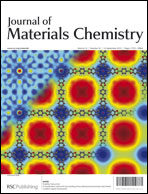Cobalt ferrite–polyaniline heteroarchitecture: a magnetically recyclable photocatalyst with highly enhanced performances†
Abstract
A cobalt ferrite–polyaniline photocatalyst is successfully prepared by in situ oxidative polymerization. The excellent magnetic properties of CoFe2O4 are maintained in the composite to some extent, and therefore the photocatalyst can be separated easily by an external magnetic field. A significant adsorption can be observed in the case of the anionic dyes and neutral dyes because the negatively charged groups or the electron-rich groups of these dyes undergo chemical interactions with the positively charged backbone of polyaniline (PANI). Such an adsorption helps in promoting the photodegradation of the dyes. It is interesting that although CoFe2O4 alone is an inactive visible-light-driven photocatalyst, the combination of CoFe2O4 nanoparticles with PANI leads to high photocatalytic activity for the degradation of the dyes under visible light irradiation. The dramatic enhancement in photoactivity can be attributed to the excited state electrons in PANI which can migrate to the conduction band (CB) of CoFe2O4, and the photogenerated holes in the valence band (VB) of CoFe2O4 which can directly transfer to the HOMO of PANI, effectively preventing a direct recombination of electrons and holes. Due to electrostatic repulsion, the cationic dyes containing positively charged groups cannot easily gain access to the positively charged backbone of PANI, giving very low photodegradation rates.


 Please wait while we load your content...
Please wait while we load your content...